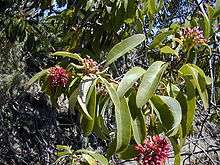Santalum freycinetianum
Santalum freycinetianum, the forest sandalwood,[2] Freycinet sandalwood, or ʻIliahi, is a species of flowering tree in the European mistletoe family, Santalaceae, that is endemic to the Hawaiian Islands. Its binomial name commemorates Henri Louis Claude de Saulces de Freycinet, a 19th-century French explorer.[3] ʻIliahi inhabits dry, coastal mesic, mixed mesic, and wet forests on Oʻahu, Kauaʻi, Lānaʻi, Maui, and Molokaʻi at elevations of 250–950 m (820–3,120 ft). It grows in areas that receive 500–3,800 mm (20–150 in) of annual rainfall. Like other members of its genus, ʻiliahi is a root hemi-parasite, deriving some of its nutrients from the host plant; common hosts include koa (Acacia koa), koaiʻa (Acacia koaia), and ʻaʻaliʻi (Dodonaea viscosa).[4]
| Santalum freycinetianum | |
|---|---|
 | |
| S. freycinetianum var. lanaiense | |
| Scientific classification | |
| Kingdom: | Plantae |
| Clade: | Tracheophytes |
| Clade: | Angiosperms |
| Clade: | Eudicots |
| Order: | Santalales |
| Family: | Santalaceae |
| Genus: | Santalum |
| Species: | S. freycinetianum |
| Binomial name | |
| Santalum freycinetianum | |
| Varieties | |
|
S. f. var. freycinetianum | |
Varieties
Uses
Non-medicinal
The ʻlaʻau ʻala (heartwood) of ʻiliahi contains valuable, aromatic essential oils. Trees were harvested for export to China between 1791–1840, where the hard, yellowish-brown wood was made into carved objects, chests, and incense. The ʻiliahi trade peaked from 1815 to 1826.[6] Native Hawaiians used the wood to make pola, the deck on a waʻa kaulua (double-hulled canoe). Powdered ʻlaʻau ʻala was used as a perfume and added to kapa cloth.[7]
Medicinal
Native Hawaiians combined leaves and bark of the ʻiliahi with naio (Myoporum sandwicense) ashes to treat kepia o ke poʻo (dandruff) and liha o ka lauoho (head lice). ʻIliahi shavings mixed with ʻawa (Piper methysticum), nioi (Eugenia reinwardtiana), ʻahakea (Bobea spp.), and kauila (Alphitonia ponderosa) was used to treat sexually transmitted diseases.[6]
References
| Wikimedia Commons has media related to Santalum freycinetianum. |
| Wikispecies has information related to Santalum freycinetianum |
- "Santalum freycinetianum". Germplasm Resources Information Network (GRIN). Agricultural Research Service (ARS), United States Department of Agriculture (USDA). Retrieved 2011-03-07.
- "Santalum freycinetianum". Natural Resources Conservation Service PLANTS Database. USDA. Retrieved 5 November 2015.
- Little Jr., Elbert L.; Roger G. Skolmen (1989). "ʻIliahi, Freycinet sandalwood" (PDF). Common Forest Trees of Hawaii (Native and Introduced). United States Forest Service.
- Allen, James A. (2003-01-01). "Santalum freycinetianum Gaudich". Tropical Tree Seed Manual. Reforestation, Nurseries & Genetics Resources. Archived from the original (PDF) on July 24, 2011. Retrieved 2009-03-03.
- "Santalum freycinetianum var. freycinetianum". Germplasm Resources Information Network (GRIN). Agricultural Research Service (ARS), United States Department of Agriculture (USDA). Retrieved 2011-03-07.
- "iliahi". Hawaiian Ethnobotany Online Database. Bernice P. Bishop Museum. Retrieved 2009-03-03.
- Medeiros, A. C.; C.F. Davenport; C.G. Chimera (1998). "Auwahi: Ethnobotany of a Hawaiian Dryland Forest" (PDF). Cooperative National Park Resources Studies Unit, University of Hawaiʻi at Mānoa. Cite journal requires
|journal=(help)
External links
- "Sandalwood trade". Hawaiʻi History Library. HawaiiHistory.org.
- Merlin, Mark D.; Lex A.J. Thomson; Craig R. Elevitch (April 2006). "Santalum ellipticum, S. freycinetianum, S. haleakalae, and S. paniculatum (Hawaiian sandalwood)" (PDF). The Traditional Tree Initiative. Cite journal requires
|journal=(help) - "ʻIliahi". Native Hawaiian Plants. Kapiʻolani Community College.
